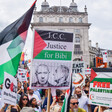Rights and Accountability 18 January 2017

Police stand guard in front of the car driven by Yaqoub Abu al-Qiyan when he was shot dead in Umm al-Hiran, a Bedouin village that Israel seeks to evacuate, on 18 January.
ActiveStillsThis story was updated on Thursday, 19 January to include new findings by Forensic Architecture.
A Palestinian citizen of Israel was killed after police fired on his vehicle in the Naqab village of Umm al-Hiran in the south of the country on Wednesday. A sergeant was also killed and another officer was injured during the pre-dawn raid to demolish several homes in the Bedouin village.
Israeli police asserted that Yaqoub Abu al-Qiyan, 50, deliberately ran over and killed the policeman, 37-year-old Erez Levi.
Police spokesperson Micky Rosenfeld stated that “a vehicle driven by a terrorist from the Islamic Movement intended to strike a number officers and carry out an attack.”
The Islamic Movement is a Palestinian political organization, the northern branch of which is banned by Israel. The northern branch’s leader, Sheikh Raed Salah, was released by Israel after nine months of imprisonment on Tuesday and was present in Umm al-Hiran on Wednesday.
Police told media that they are looking for ties between Abu al-Qiyan and Islamic State.
“They say that after raiding his house they found Israeli newspapers with headlines about the group, though his family denies any such relationship, saying he is just a math teacher at the local high school in the Bedouin town of Hura,” the Tel Aviv newspaper Haaretz reported.
Rosenfeld made further claims of Islamic State ties on Twitter:
Witnesses interviewed by multiple media outlets disputed Israel’s version of events, saying that Abu al-Qiyan was attempting to leave the scene and it was Israeli police fire that caused him to lose control of his vehicle and crash into police.Video
Police aerial surveillance video of the incident leaked to the media appears to support eyewitness claims that Abu al-Qiyan accelerated only after he was fired on.
“A short while after the video was leaked to the media, the police released an edited version with captions explaining how the incident unfolded,” Haaretz reported. “The captions did not mention the gunfire and the beginning of the incident is seen as the moment the car started accelerating.”
In a zoomed-in version of the video published by Haaretz, the car is seen traveling at a slow speed. At seven seconds into the clip, a police officer positioned in front of the car is seen opening fire towards the vehicle. Several seconds after the gunfire, the car is seen speeding up and veering off the road and into a group of police, before ultimately crashing into another vehicle: “Following the release of the video, Public Security Minister Gilad Erdan tweeted that the police gunfire that can be seen at the beginning of the video were warning shots which were not directed at the driver,” Haaretz stated.“Erdan said the warning shots were fired after [Abu] al-Qiyan refused to heed calls to halt, and instead he attempted to run over the police force.”
Erdan’s claim appears to be contradicted by a preliminary investigation released by the UK-based research group Forensic Architecture on Thursday.
The investigation synchronizes the aerial footage with video recorded on the ground by Activestills, in which the gunfire seen on the video is heard:
Forensic Architecture states that its investigation shows that Abu al-Qiyan’s vehicle was “proceeding slowly towards the general direction of the policemen when it was shot three times. This was followed by a burst of four gunshots.”Forensic Architecture finds that four seconds after the first gunshot, the car changes its course and headed towards a group of police. Six seconds after the first shot, the car hits the officers.
“This is followed by a long burst of fire. The car’s horn is heard continuously sounding, suggesting that the driver might be incapacitated,” according to Forensic Architecture. The car comes to a complete stop 13 seconds after the first shot.
“We can also identify the clear sound of a single gunshot at a time [when] several policemen are seen surrounding the stopped vehicle,” Forensic Architecture adds. “This last shot is consistent with what the Israeli security personnel calls ‘verification of killing’ – the shooting to kill of already neutralized people.”
An Israeli army medic was convicted of manslaughter earlier this month for shooting at the head of an incapacitated Palestinian man who allegedly stabbed another soldier last year. During that soldier’s trial, a settler security chief called as a witness by the defense told the court that shooting at the heads of incapacitated alleged Palestinian attackers is a routine practice by Israeli occupation forces.
“Culture of lying”
The human rights group Adalah rejected the police’s claim – echoed by Prime Minister Benjamin Netanyahu, who linked the incident to a car ramming attack targeting soldiers earlier this month – that Abu al-Qiyan was killed while carrying out a terror attack.
“This statement reflects the Israeli police’s culture of lying. A few weeks ago, the Israeli police also accused Arab citizens of the state of launching arson attacks, which has not been proven at all,” Adalah stated, referring to wildfires that swept through the country in November.

Bedouin women sit in front of the rubble of demolished houses in Umm al-Hiran on 18 January.
ActiveStillsRaed Abu al-Qiyan, an activist in Umm al-Hiran village, told the AFP news agency that the slain man owned one of the structures slated for demolition. Rosenfeld, the police spokesperson, said that Israeli forces were carrying out orders to destroy 15 structures built without a permit.
Several others were hospitalized after Israeli forces “used sponge-tipped bullets, tear gas and stun grenades to violently suppress locals and supporters who had gathered to resist the demolitions,” the Ma’an News Agency reported.
Ayman Odeh, a Palestinian member of Israel’s parliament, the Knesset, was among those injured. He stated on video that he was directly sprayed in the face with tear gas, and that police fired rubber-coated bullets that hit him in the head and back.
Footage from the scene shows Israeli forces wrestling protesters to the ground:
The deadly demolition raid in Umm al-Hiran comes a week after police destroyed 11 homes in Qalansawa, a Palestinian town in Israel.Ahead of that raid, Netanyahu promised settlers due to be evacuated from Amona, an unauthorized outpost in the occupied West Bank, that he would apply the law equally by cracking down on “illegal construction” across the country.
Palestinian citizens of Israel face severe restrictions on the amount of land they are allowed to use or live on, and receive a disproportionately small allocation of housing tenders, forcing many to build without permits.
Demolitions and displacement
The demolitions in Qalansawa took residents by surprise. But people in Umm al-Hiran have been braced for the destruction of their village, as Israel plans to build a Jewish settlement in its place.
A large mobilization of protesters kept Israel’s bulldozers away from Umm al-Hiran in November last year.
“The Israeli judiciary and the government are responsible for the killing in the village today,” Adalah stated on Wednesday. “The Israeli [high court] decision to allow the state to proceed with its plan to demolish the village, which has existed for 60 years, in order to establish a Jewish town called ‘Hiran’ over its ruins, is one of the most racist judgments that the court has ever issued.”
According to Adalah, the residents of Umm al-Hiran were expelled from their ancestral lands in Khirbet Zubaleh in 1948, when hundreds of Palestinian towns and villages were depopulated during the establishment of the State of Israel.

Demonstrators march in Jaffa to protest the killing of Yaqoub Abu al-Qiyan during a home demolition raid in Umm al-Hiran on 18 January.
ActiveStillsSarah Leah Whitson, director of Human Rights Watch’s Middle East division, called on Israel to investigate Wednesday’s deadly incident and “abandon the discriminatory plan to raze Umm al-Hiran.”
“As in the West Bank, Israel discriminates against Bedouins and Palestinians more generally inside its borders in its planning policies, which seek to maximize control of land for Jewish communities,” she said.
The Joint List, a coalition of parties led by Palestinian citizens of Israel in the Knesset, accused the police of lying. Several lawmakers from the party were in Umm al-Hiran during the raid.
“The Netanyahu government has effectively declared a military war against our people in the 1948 area,” the party stated, referring to the territory of present-day Israel. “The war started with demolitions in Qalansawa, and it is continuing today in Umm al-Hiran.”
Palestinians in Israel declared a general strike and three days of mourning following the deadly raid. Rallies were held throughout Israel, the West Bank and Gaza Strip to protest the demolitions:





